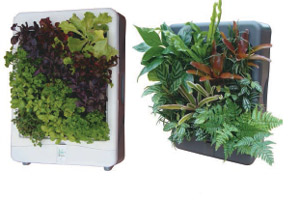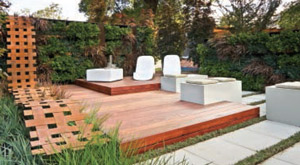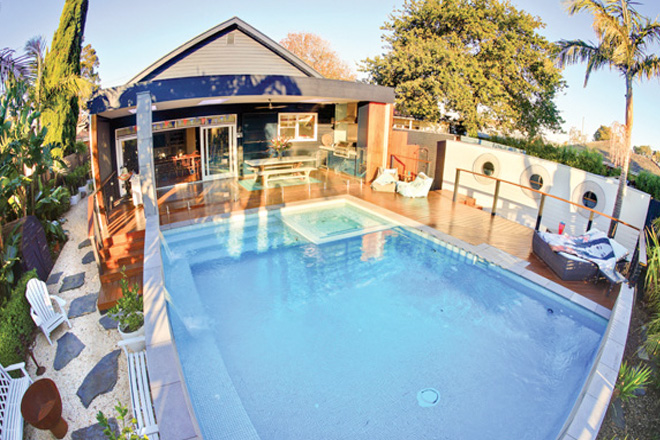
Words: Catherine Stewart
Walls dripping with foliage and flowers conjure images of the hanging gardens of Babylon as a way of making a building or a city into a verdant paradise. On our traditional quarter-acre block it’s easy to make a garden on the level, but in tightly populated cities and towns, finding places to grow plants can be quite a challenge. If there’s one thing we do have plenty of in those environments, it’s walls, and they often express all that can be negative about urban living — tall and forbidding or blank and bare.
Clothing walls with plants can seem like you’re trying to force them to grow in ways nature didn’t intend but, if you look around, you’ll find lots of places where plants are growing in all sorts of ways — even upside down. Trees wrap their roots around cliff-side boulders, ferns cascade down from tiny crevices behind rock waterfalls, and bromeliads, orchids and staghorns cling onto rocks and tree branches. Most plants just need to present an adequate leaf area to the sun for photosynthesis and have a stable medium in which to spread their roots and find water and nutrients.
The beauty of green walls
Vertical gardens, or green walls, aren’t just beautiful. They can have an amazing deadening effect on sound transmission through walls as well as insulate from heat transfer and prevent the reradiated heat that causes a heat island effect in built-up urban areas. All that moist surface area intercepts and catches airborne dust and pollutants while increasing relative humidity and oxygenation. Instead of a bare wall devoid of life, you have a tiny wildlife habitat, which can also help attract pollinators, essential if you’re also trying to grow fruit or vegetables nearby.
Apart from their utility, vertical gardens are a really useful design tool. Use them to make privacy screens or dividing walls between apartments and townhouses, or within your own home. The best designers can create beautiful plant pictures in which swathes and swirls of colour and texture become nature’s wall art.
Gardens both big and small
If you want to start small and see how your vertical garden works before you commit to something expensive, there’s a natty little system called the VertiScape Mini available from Living Holmes Design. Designed and made in Australia from recycled plastics, it’s only 495mm high, 350mm wide and 130mm deep, making it a practical way to begin your vertical greenery.
As Travis Holmes says, “Put it in your kitchen, on your office desk, your wall — they’re very practical. Anyone can try and successfully achieve a vertical garden of salad leaves ready for picking, pretty flowers, bold succulents or soft ferns. “Water is added to the top and then collects in a built-in reservoir at the bottom, so there’s no mess and you can recycle it through again. Available either online or through Plants Plus, Home Hardware and good nurseries, it sells for only $59.95 and there’s plenty of helpful startup information on the website at www.livingholmesdesign.com.
Full-wall vertical gardens need substantial support as some of the larger systems weigh up to 88kg per square metre when the growing medium is saturated, and you also need to make sure the wall is properly waterproofed. Walls can be clad with a waterproof ply or blueboard, although some smaller kit systems come with a waterproof backing plate of plastic or powder-coated steel. Vertical garden companies will include waterproofing in their installation costs. You also need to make sure the edges of the system are protected with a waterproof frame, as that’s where plants can easily dry out.
Water management critical
Even more than with ordinary potted plants, water management is critical to vertical garden success, both in irrigation input and the output of water that drips from the bottom of the wall. While they suit very waterwise plants, plants will fail if the wall dries out for too long. Fytowall estimates that each square metre of wall garden needs about one litre every day in winter but five litres per day through summer. Installed wall gardens usually have an automated battery-operated system that may also add fertilisers into hydroponic systems. Water is drawn from either the mains or rainwater tanks, or can be recycled. Drip trays at the bottom of the wall catch excess water and either recirculate it or send it to the stormwater.
Vertical garden companies have experts to advise you on plant choices. The main groups from which suitable plants are chosen are bromeliads, succulents, orchids, trailing plants, especially those from subtropical environments, small strap-leaf plants, sedges and ferns. Edible plants include salad leaves, strawberries, cherry tomatoes and eggplant as well as a variety of herbs such as oregano, thyme and parsley. Remember that many edible plants are annuals, which require regular replacement.
Some easy modular systems
Modular systems are made up of individual small mesh crates hung from battens on the wall. Into each crate is inserted a pack of growing media, often held inside a geotextile fabric lining. Some companies use a good-quality potting mix, while others use an inorganic non-soil medium. Plants are inserted through openings in the fabric.
Greenwall Company has installed greenwalls in some of Australia’s premier commercial locations, including Google headquarters in Sydney, Adelaide Zoo and King George Square in Brisbane. Using an inorganic growing medium with an adjustable substrate depth, the vertical gardens are watered by a drip irrigation system, which can be customised to your requirements, such as recycling water or being fully automated. Owner and horticulturist Mark Paul grows a huge variety of perfectly adapted plants, many from impoverished habitats with seasonal drought so they can thrive in these challenging environments.
Living Holmes Design also designs and installs a larger version of the VertiScape enclosed vertical garden system or a modular system of 330mm square panels, which fit into small niches or link together to cover a large wall.
Atlantis has Gro-Wall, which comprises plastic units three bays wide and two bays high with each bay holding a separate grow bag with a plant, making it easy to replace individual plants. They can either be fixed to a wall or you can fasten them back-to-back to make a freestanding greenwall. A $250 (plus delivery) kit includes three modules which assemble to 675mm wide and 1212mm high, 18 planter bags, 24 connectors and an instruction manual and DVD. The Gro-Wall™ range offers several choices, including the new Gro-Wall™ Slim, which is well suited for growing herbs and vegetables.
Fytowall uses a steel mesh cage holding a polymer resin panel as the growing medium, which is wrapped in shade cloth to give a choice of background colours. The resin holds water well and doesn’t slump or break down over time. Individual panels are 500mm high with a hydroponic irrigation line across the top, ensuring water is distributed evenly through the resin mix, avoiding dry areas at the top and saturation at the bottom. Panels can be combined to make any size greenwall. Fytowall establishes the plants on the flat first so that by the time the panels are installed there’s already a good coverage. Irrigation design is critical, often requiring different zones within the one vertical garden to accommodate plants with higher water needs or exposed to more heat from growing lights or sunshine. You can buy a smaller ready-to-mount kit garden, including plants and irrigation system, for about $1800/square metre, or an installed 4m2 greenwall costs about $6000.
Elmich manufactures polypropylene modules which are clipped together into an open box 560mm x 500mm x 250mm. A geotextile lining bag is inserted and filled with potting mix, top-covered with another geotextile sheet and then a lid snapped on. An open-front grille has spaces for 16 plants, pre-grown in flat trays, which are planted through slits cut into the fabric. Modules can be hung from vertical pilasters attached to the wall or inserted into purpose-built racks and installed with automated irrigation systems and drip trays for reticulating excess water.
Junglefy installs greenwalls made from ecoVert Pro modules, each 547mm high by 336mm wide and 130mm deep. Made from recycled lightweight plastic, the modules hold a geotextile bag filled with a specially developed planting medium containing perlite, organic matter and slow-release fertiliser. Plants are inserted into each of the 15 pockets. Once the included nutrients are depleted, the plants are fed hydroponically and all excess water is recycled back through the system.
Up She Grows has click-together recycled polypropylene modules with a geotextile lining, which hold 16 plants and sell for $65. These are from the Woolly Pocket range and can be used outside in the garden or inside the home. Up She Grows also has beautiful hand-crafted teak tables that hold four modules, making a unique living cube.
An alternative to plastic
Felt walls are an alternative to plastic modules and the system used by the famous Patrick Blanc, a world leader in greenwall design. You can build a felt or rockwool wall yourself, or Lushe can install one for you. Unlike the modules, felt walls are only a few centimetres deep and rely on a constant hydroponic drip system. Plants need to have very shallow root systems, growing naturally as epiphytes on trees or lithophytes (on rocks).
Several layers of felt are attached to a waterproof backing and plants are pushed through slits in the upper felt and tacked on to a lower felt surface. You can even try germinating seed of shallow-rooted annuals such as sweet alice in pockets in the felt wall. A drip pipe at the bottom of the wall collects excess water.





